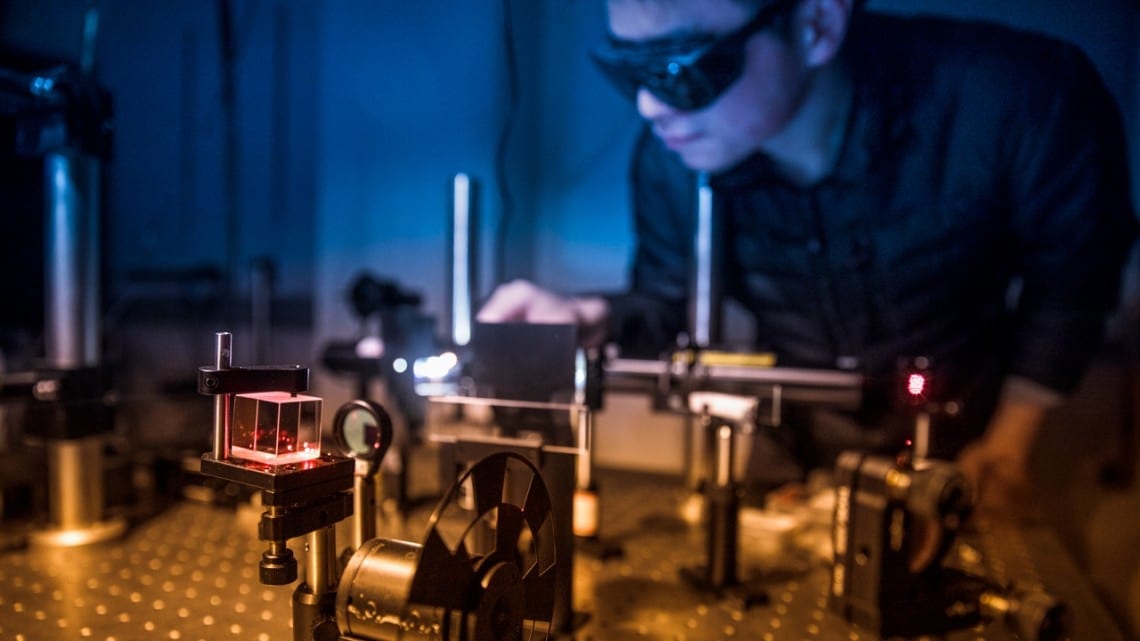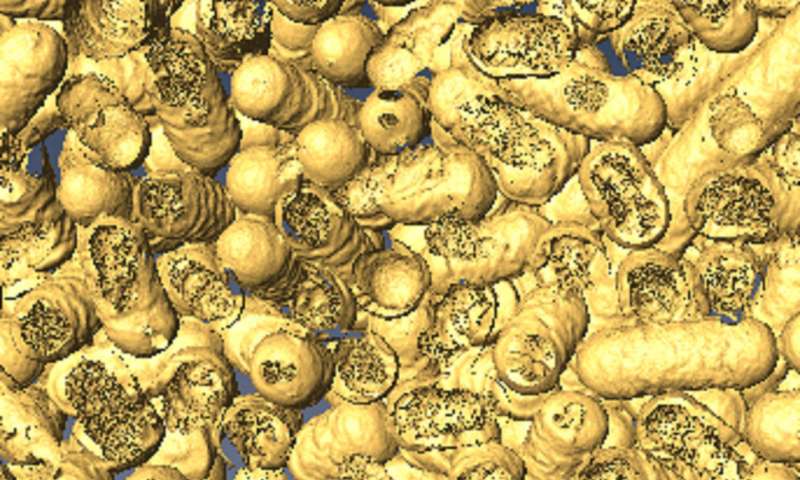
Shengwei Jiang, postdoctoral researcher, aligns an optical setup for magneto-optical Kerr rotation microscopy measurements on atomically thin magnets.
Cornell researchers have become the first to control atomically thin magnets with an electric field, a breakthrough that provides a blueprint for producing exceptionally powerful and efficient data storage in computer chips, among other applications.
The research is detailed in the paper, “Electric-field switching of two-dimensional van der Waals magnets,” published March 12 in Nature Materials by Jie Shan, professor of applied and engineering physics; Kin Fai Mak, assistant professor of physics; and postdoctoral scholar Shengwei Jiang.
In 1966, Cornell physicist David Mermin and his postdoc Herbert Wagner theorized that 2-D magnets could not exist if the spins of their electrons could point in any direction. It wasn’t until 2017 that some of the first 2-D materials with the proper alignment of spins were discovered, opening the door to an entirely new family of materials known as 2-D van der Waals magnets.
Shan and Mak, who specialize in researching atomically thin materials, jumped on the opportunity to research the new magnets and their unique characteristics.
“If it’s a bulk material, you can’t easily access the atoms inside,” said Mak. “But if the magnet is just a monolayer, you can do a lot to it. You can apply an electric field to it, put extra electrons into it, and that can modulate the material properties.”
Using a sample of chromium triiodide, the research team set out to do just that. Their goal was to apply a small amount of voltage to create an electric field and control the 2-D compound’s magnetism, giving them the ability to switch it on and off.
To achieve this, they stacked two atomic layers of chromium triiodide with atomically thin gate dielectrics and electrodes. This created a field-effect device that could flip the electron-spin direction in the chromium triiodide layers using small gate voltages, activating the magnetic switching. The process is reversible and repeatable at temperatures under 57-degrees Kelvin.
The discovery is an important one for the future of electronics because “the majority of existing technology is based on magnetic switching, like in memory devices that record and store data,” said Shan. However, magnets in most modern electronics don’t respond to an electric field. Instead, a current is passed through a coil, creating a magnetic field that can be used to switch the magnet on and off. It’s an inefficient method because the current creates heat and consumes electrical power.
Two-dimensional chromium-triiodide magnets have a unique advantage in that an electric field can be directly applied to activate the switching, and very little energy is required.
“The process is also very effective because if you have a nanometer thickness and you apply just one volt, the field is already 1 volt per nanometer. That’s huge,” said Shan.
The research team plans to continue exploring 2-D magnets and hopes to form new collaborations around campus, including with scientists and engineers who can help them find new 2-D magnetic materials that, unlike chromium triiodide, can work at room temperature.
“In a sense, what we have demonstrated here is more like a device concept,” said Mak. “When we find the right kind of material that can operate at a higher temperature, we can immediately apply this idea to those materials. But it’s not there yet.”
Learn more: Breakthrough made in atomically thin magnets
The Latest on: Atomically thin magnets
[google_news title=”” keyword=”atomically thin magnets” num_posts=”10″ blurb_length=”0″ show_thumb=”left”]
via Google News
The Latest on: Atomically thin magnets
- Arnold Magnetic Technologies' custom electromagnetic capabilitieson May 9, 2024 at 10:05 pm
Arnold Magnetic Technologies Corporation, a subsidiary of Compass Diversified and global manufacturer of high-performance magnets and precision thin metals, highlights its custom electromagnetics used ...
- Research Bits: May 7on May 7, 2024 at 12:01 am
Researchers led by Deep Jariwala and Roy Olsson have developed a first-of-its-kind high-temperature-resistant memory device that can reliably store data at temperatures as high as 600° Celsius.
- 'Better than graphene' material development may improve implantable technologyon May 6, 2024 at 7:01 am
Move over, graphene. There's a new, improved two-dimensional material in the lab. Borophene, the atomically thin version of boron first synthesized in 2015, is more conductive, thinner, lighter, ...
- Study shows ultra-thin two-dimensional materials can rotate the polarization of visible lighton April 22, 2024 at 9:01 am
Prof Ashish Arora from IISER adds, "Even the bulky magnets, which are also required for optical isolators, could be replaced by atomically thin 2D magnets." This would drastically reduce the size ...
- Study shows: 2D materials rotate light polarizationon April 21, 2024 at 5:00 pm
Prof Ashish Arora from IISER adds: "Even the bulky magnets, which are also required for optical isolators, could be replaced by atomically thin 2-D magnets." This would drastically reduce the size ...
- 2D materials rotate light polarizationon April 21, 2024 at 5:00 pm
Prof Ashish Arora from IISER adds: "Even the bulky magnets, which are also required for optical isolators, could be replaced by atomically thin 2-D magnets." This would drastically reduce the size ...
- Study shows: 2D materials rotate light polarisationon April 18, 2024 at 5:00 pm
Prof Ashish Arora from IISER adds: "Even the bulky magnets, which are also required for optical isolators, could be replaced by atomically thin 2-D magnets." This would drastically reduce the size of ...
- Propelling atomically layered magnets toward green computerson April 4, 2024 at 11:19 pm
"Moreover, the atomically layered structure of our device ... component that can directly induce switching in the ultra-thin magnet interfaced with the tungsten ditelluride.
- Atomic magnetism finally caught on cameraon October 5, 2022 at 6:24 am
Instead of using light like optical microscopes, TEMs use beams of electrons to irradiate extremely thin samples ... had to make an atomically sharp probe to measure the tiny magnetic fields.
via Bing News












